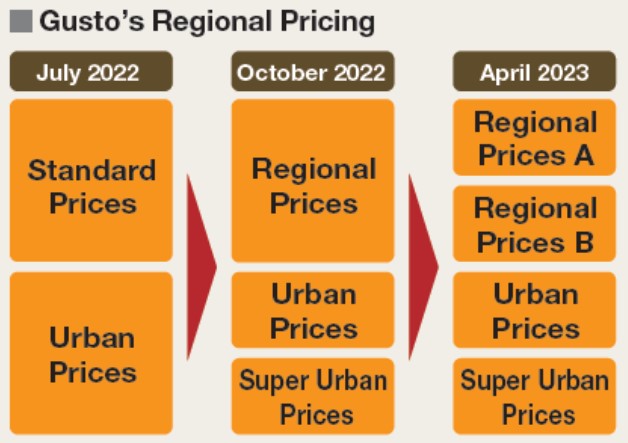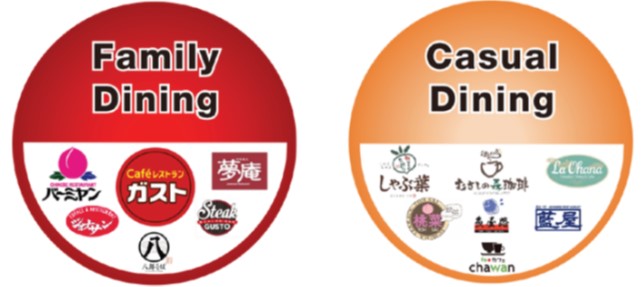Although the Skylark Group raised prices for some products in 2022 due to the impact of soaring food prices due to the depreciation of the yen and soaring logistics and energy prices, Gusto and Bamiyan adopted regional prices. We are implementing a pricing strategy that fits local demand by taking measures such as curbing the range of price increases in rural areas where there is a strong sense of defense in daily life due to the rise in gasoline prices and other factors, as there is a large difference in the rate of recovery in consumption depending on the region.
The Group also has more than 20 diverse bands, including family dining brands such as Gusto and Bamiyan, which serve as food infrastructure, and casual dining brands such as Syabu-Yo and Musashinomori Coffee, which offer an enriched dining out experience, responding to the needs of the times with different menu and pricing strategies.
Results
Implementation of a Detailed Pricing Strategy in Response to Significant Inflation
Price increases in FY2022 resulted in an increase in price per check and an improvement in gross margins.
Since the fall of 2022, Gusto has been minimizing the impact of a decrease in the number of customers resulting from price increases by introducing regional prices in three categories: “Regional,” “Urban,” and “Super Urban.” In 2023, we further introduced four categories of price settings, leading to introduction of low-priced lunches in the Kyushu region. In addition to recovering customer numbers based on market analysis by region, we will also implement measures to contribute to the increase in customer numbers in the development of the overall brand menu. Specifically, by strengthening the lineup of low-priced daily lunches and voluminous products, and introducing mini-size menus, we will promote the enjoyment of choosing products, the add-on sales ratio, and the enhancement of child services. We will provide value that is even more user-friendly.

Store Portfolio and Menu Item Development in Line With the Times
In the post-COVID-19 era, there are polarized needs for eating out where customers want to enjoy meals casually and enjoy delicious food and a fulfilling experience by eating out. The Skylark Group is developing both family dining and casual dining menu items to meet such needs through the Group’s diverse portfolio.
■Business Portfolio Tailored to the Times

Developing Attractive Menu Items That Lead Customers to Visit Stores with a Particular Purpose
- Collaboration with Other Companies That Have High News Value
In the fall of 2022, Gusto released its Kando Hamburg, a product jointly developed with Chef Shusaku Toba, who received one Michelin star for four years in a row and took on the challenge to create a course meal, a first in Gusto’s history. This received a great response from customers across the country, leading to visits to stores for a specific purpose, something that is important in the post-COVID-19 era. We are taking on new challenges, such as the January 2023 release of Chanko Nabe under the supervision of the restaurant Chanko Kirishima in Ryogoku (area of Sumidaku, Tokyo) directly related to the Michinoku stable of sumo wrestlers.
- Enhancement of Health-Conscious Menus
The group focuses on the development of healthconscious menu items for each brand. In 2022, Gusto developed a low-carbohydrate menu under the supervision of Ms. Naoyo Fujimoto, a low-carbohydrate food specialist. We introduce new products every season and have received a very high level of support from customers who are concerned about carbohydrates.
- Improving the Quality of Symbol Products and New Menu Item Development
Each brand is working to improve menu item quality to improve customer satisfaction, leading to an increase in overall satisfaction scores.
Examples of Changes in October 2022
Gusto Cheese IN Hamburger
Result: Customer satisfaction increased by 2.2%
Revision: Increased cheeses available from 10 to 12 kinds. Changed meat quality and formulation for a richer, melt-in-your-mouth quality.
Gusto Daily Lunch
Result: Customer satisfaction increased by 4.9%
Revision: Revised materials, increased number of items, and increased vegetable volume
Examples of Changes in April 2023
Gusto: New menu development (fresh homemade pasta, THE Gusto Hamburg steak) and quality improvement (Musashino Takumi Hamburg steak)
Future Initiatives
Creating an Integrated Organization from Planning to Analysis
Since April 2023, we have structured our marketing organization that consistently performs product planning and development, introduction of products at stores, sales promotion activities, and finally product post-introduction analysis. In this way, we will plan and develop menus with the aim of maximizing the effect of sales promotions.
Over the years, we have accumulated big data, including point-of-sale (POS) data and mobile app coupon usage history, which we analyze in detail to formulate menu and pricing strategies. We share the big data analysis with our management team on a weekly basis to identify and understand the changing market in detail based on segmented consumer consumption trends, leading to the speedy development of menus that are in demand.
Cross-departmental cost reduction project
Through the cross-departmental cost reduction project conducted by purchase, production, menu development, and sales departments, we are promoting measures to reduce costs by 3 billion yen in FY2023, including 1 billion yen in purchasing reform, 800 million yen in production and logistics reform, 1 billion yen in price and cost optimization, and a 200 million yen reduction from food loss reduction. We will take full advantage of the strengths of our business model, which covers everything from procurement to production, logistics, and provision, and promote efficiency in all processes to realize initiatives to increase the value we provide to customers.